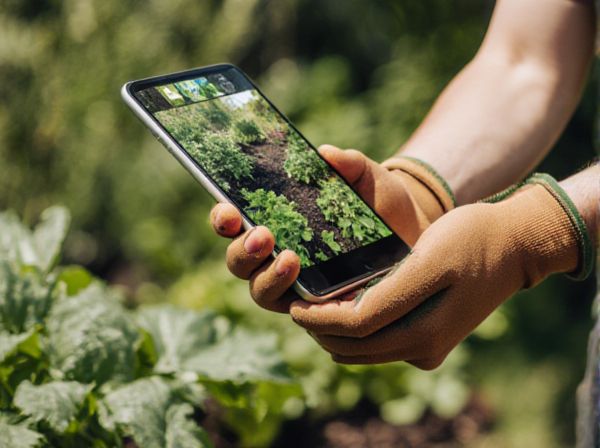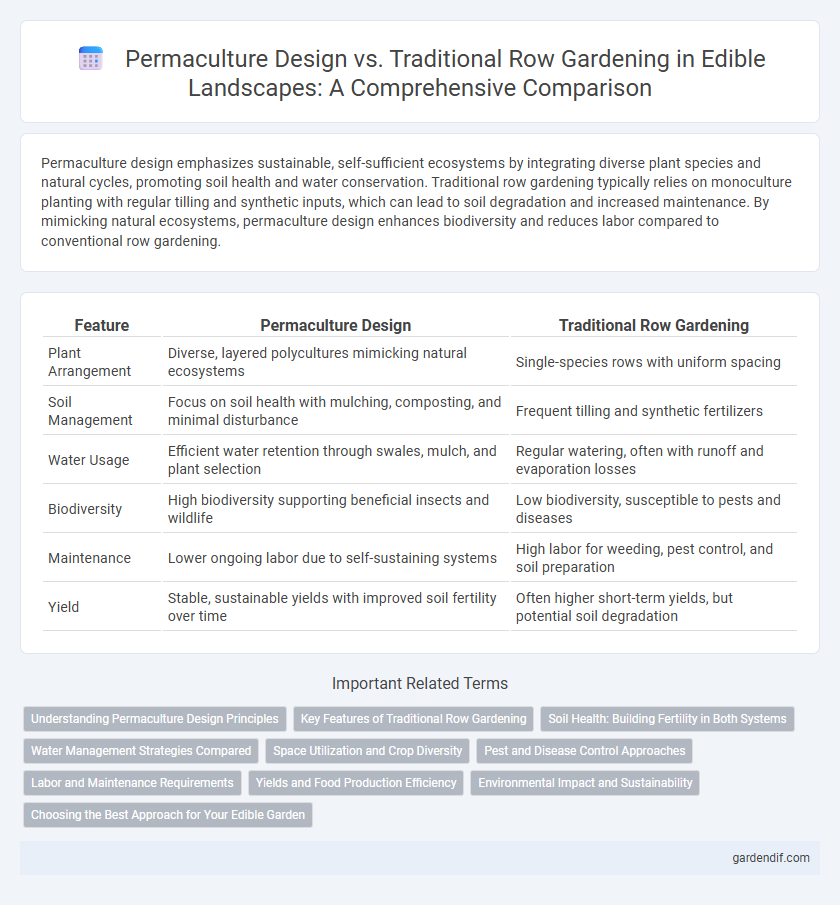
Permaculture design vs Traditional row gardening Illustration
Permaculture design emphasizes sustainable, self-sufficient ecosystems by integrating diverse plant species and natural cycles, promoting soil health and water conservation. Traditional row gardening typically relies on monoculture planting with regular tilling and synthetic inputs, which can lead to soil degradation and increased maintenance. By mimicking natural ecosystems, permaculture design enhances biodiversity and reduces labor compared to conventional row gardening.
Table of Comparison
| Feature | Permaculture Design | Traditional Row Gardening |
|---|---|---|
| Plant Arrangement | Diverse, layered polycultures mimicking natural ecosystems | Single-species rows with uniform spacing |
| Soil Management | Focus on soil health with mulching, composting, and minimal disturbance | Frequent tilling and synthetic fertilizers |
| Water Usage | Efficient water retention through swales, mulch, and plant selection | Regular watering, often with runoff and evaporation losses |
| Biodiversity | High biodiversity supporting beneficial insects and wildlife | Low biodiversity, susceptible to pests and diseases |
| Maintenance | Lower ongoing labor due to self-sustaining systems | High labor for weeding, pest control, and soil preparation |
| Yield | Stable, sustainable yields with improved soil fertility over time | Often higher short-term yields, but potential soil degradation |
Understanding Permaculture Design Principles
Permaculture design integrates ecological principles such as diversity, natural patterns, and sustainable resource use to create self-sufficient food systems, contrasting with traditional row gardening that relies on linear planting and external inputs. Key permaculture principles include observing natural ecosystems, promoting soil health through mulching and composting, and designing for water efficiency with techniques like swales and rain gardens. Emphasizing permaculture design leads to resilient, low-maintenance edible landscapes that enhance biodiversity and long-term productivity.
Key Features of Traditional Row Gardening
Traditional row gardening features evenly spaced, linear rows that allow for easy access, consistent watering, and efficient pest management, optimizing crop growth within a controlled environment. This method emphasizes monoculture planting, simplifying planting and harvesting while potentially increasing vulnerability to pests and soil depletion. Soil preparation typically involves tilling and fertilization to enhance fertility and improve plant root development.
Soil Health: Building Fertility in Both Systems
Permaculture design enhances soil health by integrating diverse plant species and organic layers that promote natural nutrient cycling and microbial diversity, fostering long-term soil fertility. Traditional row gardening often relies on monoculture and synthetic fertilizers, which can degrade soil structure and reduce beneficial organisms over time. Emphasizing cover crops, compost, and minimal disturbance in permaculture supports resilient, nutrient-rich soil compared to conventional tillage practices.
Water Management Strategies Compared
Permaculture design utilizes advanced water management strategies such as swales, rain gardens, and mulching to maximize water retention and minimize runoff, promoting sustainable soil hydration. Traditional row gardening often relies on frequent irrigation and furrow methods which can lead to higher water consumption and increased erosion. Incorporating permaculture principles enhances water efficiency and soil health, reducing the need for external irrigation inputs.
Space Utilization and Crop Diversity
Permaculture design maximizes space utilization by mimicking natural ecosystems, integrating vertical layering, companion planting, and perennial crops to create dense, self-sustaining food systems. Traditional row gardening often uses monoculture planting with wide spacing, limiting crop diversity and resulting in less efficient land use. By fostering diverse plant species and intercropping, permaculture enhances biodiversity and soil health while optimizing productivity per square foot.
Pest and Disease Control Approaches
Permaculture design emphasizes biodiversity and natural pest control by integrating companion planting, polycultures, and habitat for beneficial insects, which enhances ecosystem resilience against pests and diseases. Traditional row gardening often relies on monoculture practices and chemical pesticides, increasing vulnerability to specific pests and disease outbreaks. Implementing permaculture methods reduces chemical inputs and promotes long-term soil and plant health through ecological balance and pest predator support.
Labor and Maintenance Requirements
Permaculture design significantly reduces labor and maintenance requirements compared to traditional row gardening by emphasizing perennial plants, polycultures, and natural ecosystem processes. This approach minimizes the need for frequent tilling, weeding, and watering through mulching, companion planting, and soil-building techniques. Traditional row gardening relies heavily on regular manual labor for soil preparation, pest control, and crop rotation, leading to higher ongoing maintenance efforts.
Yields and Food Production Efficiency
Permaculture design significantly enhances food production efficiency by mimicking natural ecosystems, promoting diverse plant species that improve soil health and maximize space utilization compared to traditional row gardening. Permaculture yields are often higher per square foot due to strategic layering of crops, continuous soil enrichment through organic matter, and reduced input requirements such as synthetic fertilizers and pesticides. Traditional row gardening typically results in lower yields and less efficient land use due to monoculture planting, soil depletion, and increased vulnerability to pests and diseases.
Environmental Impact and Sustainability
Permaculture design promotes biodiversity and soil health by mimicking natural ecosystems, significantly reducing the need for synthetic fertilizers and pesticides compared to traditional row gardening. This approach enhances water retention and carbon sequestration, contributing to long-term environmental sustainability. Traditional row gardening often depletes soil nutrients and increases erosion risks, impacting local ecosystems and reducing resilience to climate change.
Choosing the Best Approach for Your Edible Garden
Permaculture design integrates diverse plant species, soil health, and natural ecosystems to create a sustainable, self-sufficient edible garden, reducing the need for external inputs like fertilizers and pesticides. Traditional row gardening offers structured planting, ease of maintenance, and straightforward pest management, ideal for growing single crops efficiently. Evaluating your local climate, available space, and long-term goals will help determine whether permaculture's holistic approach or traditional row gardening's simplicity suits your edible garden best.
Permaculture design vs Traditional row gardening Infographic

 gardendif.com
gardendif.com